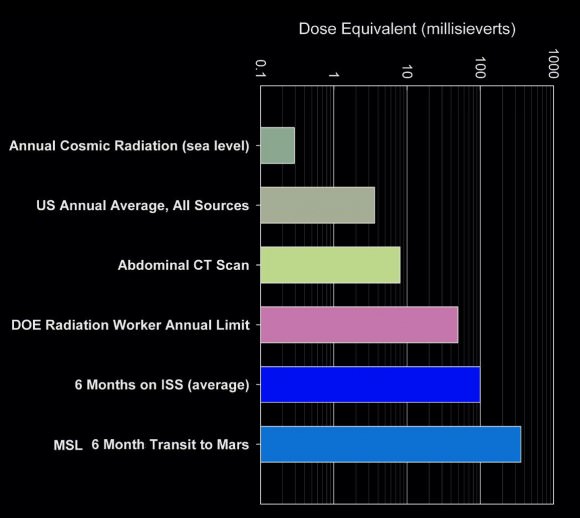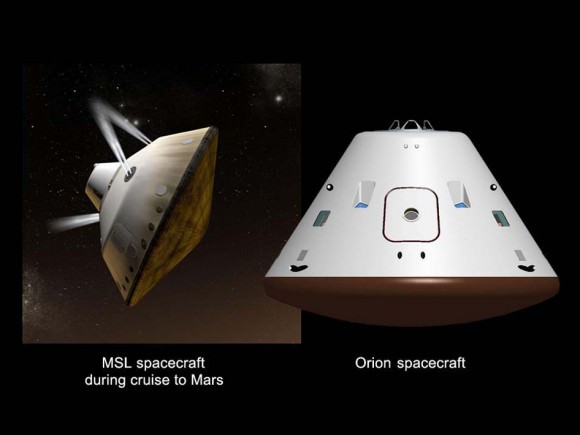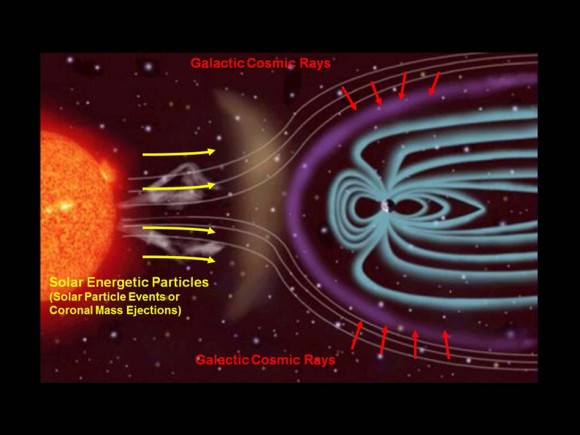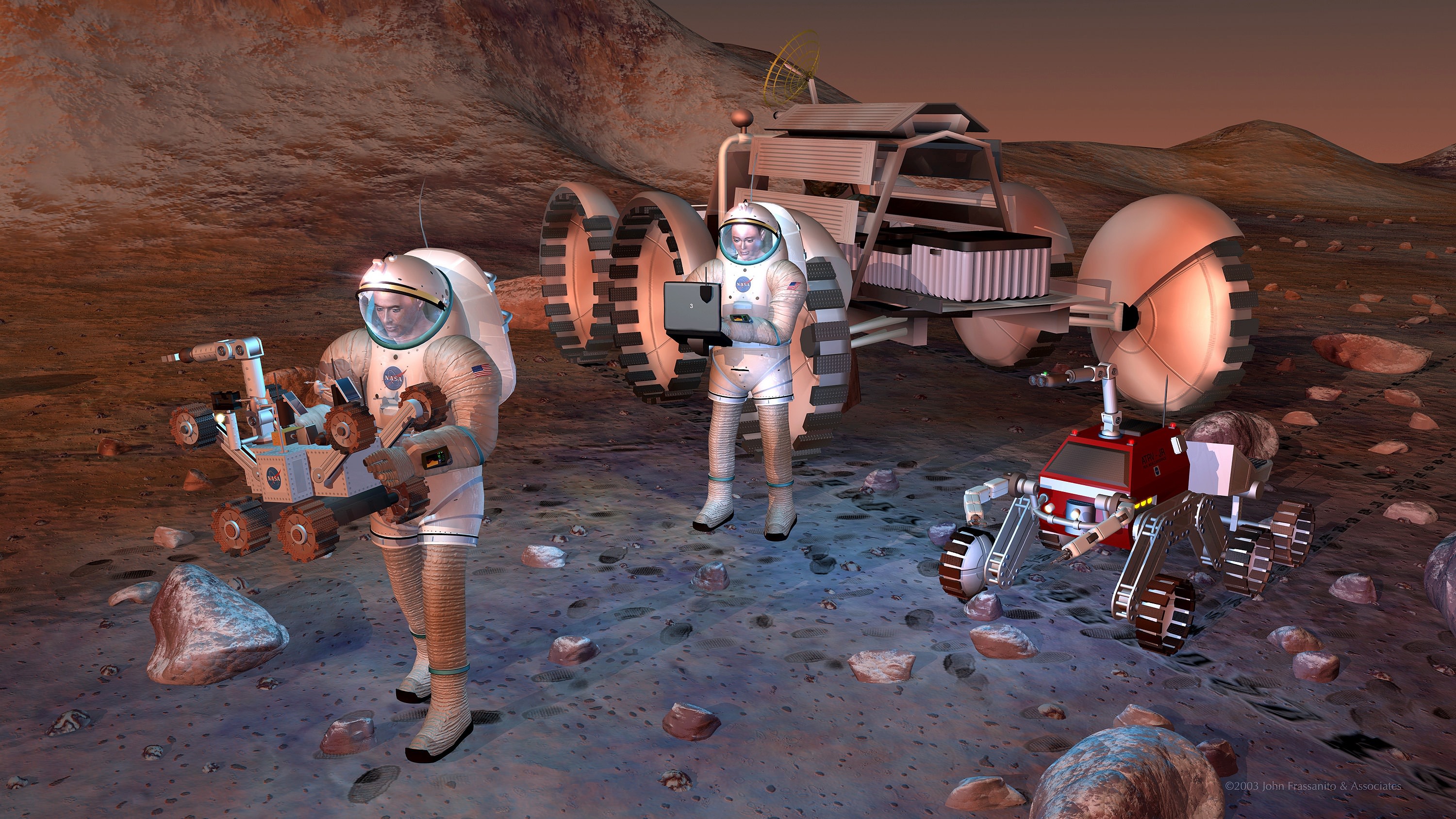New measurements of the energetic space radiation environment present in interplanetary space taken by NASA’s Curiosity rover confirm what has long been suspected – that lengthy years long voyages by astronauts to deep space destinations like Mars will expose the crews to high levels of radiation that – left unchecked – would be harmful to their health and increase their chances of developing fatal cancers.
Although the data confirm what scientists had suspected, it’s equally important to state that the space radiation data are not ‘show stoppers” for human deep space voyages to the Red Planet and other destinations because there are a multitude of counter measures- like increased shielding and more powerful propulsion – that NASA and the world’s space agencies can and must implement to reduce and mitigate the dangerous health effects of radiation on human travelers.
The new radiation data was released at a NASA media briefing on May 30 and published in the journal Science on May 31.
Indeed the new measurements collected by Curiosity’s Radiation Assessment Detector (RAD) instrument during her 253-day, 560-million- kilometer journey enroute to the Red Planet in 2011 and 2012 will provide important insights to allow NASA to start designing systems for safely conducting future human missions to Mars.
“NASA wants to send astronauts to Mars in the 2030’s,” Chris Moore, NASA’s deputy director of Advanced Exploration Systems NASA HQ, said to reporters at the media briefing.
“The Human Spaceflight and Planetary Science Divisions at NASA are working together to get the data needed for human astronauts. RAD is perfect to collect the data for that,” said Moore.
The RAD data indicate that astronauts would be exposed to radiation levels that would exceed the career limit levels set by NASA during a more than year long voyage to Mars and back using current propulsion systems, said Eddie Semones, spaceflight radiation health officer at the Johnson Space Center.

NASA’s Humans to Mars planning follows initiatives outlined by President Obama.
“As this nation strives to reach an asteroid and Mars in our lifetimes, we’re working to solve every puzzle nature poses to keep astronauts safe so they can explore the unknown and return home,” said William Gerstenmaier, NASA’s associate administrator for human exploration and operations in Washington, in a statement.
The International Space Station already in low Earth orbit and the Orion crew capsule under development will serve as very useful platforms to conduct real life experiments on resolving the health risks posed by long term exposure to space radiation.
“We learn more about the human body’s ability to adapt to space every day aboard the International Space Station, said Gerstenmaier. “As we build the Orion spacecraft and Space Launch System rocket to carry and shelter us in deep space, we’ll continue to make the advances we need in life sciences to reduce risks for our explorers. Curiosity’s RAD instrument is giving us critical data we need so that we humans, like the rover, can dare mighty things to reach the Red Planet.”
RAD was the first instrument to collect radiation measurements during the cruise phase to the Red Planet. It is mounted on the top deck of the Curiosity rover.
“Although RAD’s objective is to characterize the radiation environment on the surface of Mars, it’s also good for the cruise phase,” Don Hassler, RAD Principal Investigator at the Southwest Research Institute (SWRI) told reporters.
“Since Orion and MSL are similar sized RAD is ideal for collecting the data.”

Hassler explained that RAD measures two types of radiation that pose health risks to astronauts. First, the steady stream of low dose galactic cosmic rays (GCRs), and second the short-term and unpredictable exposures to solar energetic particles (SEPs) arising from solar flares and coronal mass ejections (CME’s).
Radiation exposure is known to increase a person’s risk of suffering fatal cancer.
Exposure is measured in units of Sievert (Sv) or milliSievert (one one-thousandth Sv). Being exposed to a dose of 1 Sievert (Sv) over time results in a five percent increased risk of developing cancer.
NASA’s current regulations limit the potential for increased cancer risk to 3 percent for astronauts currently working on the ISS in low-Earth orbit.
RAD determined that the Curiosity rover was exposed to an average of 1.8 milliSieverts per day during the 8.5 month cruise to Mars, due mostly to Galactic Cosmic Rays, said Cary Zeitlin, SWRI Principal Scientist for MSL,at the briefing. “Solar particles only accounted for about 3 to 5 percent of that.”
During a typical 6 month cruise to Mars the astronaut crews would be exposed to 330 millisieverts. That is more than 3 times the typical 6 month exposure of astronauts aboard the ISS which amounts to about 100 millisieverts. See graphic above.
“The 360 day interplanetary round trip exposure would be 660 millisieverts based on chemical propulsion methods,” Zeitlin told Universe Today. “A 500 day mission would increase that to 900 millisieverts.”
By comparison, the average annual exposure for a typical person in the US from all radiation sources is less than 10 millisieverts.
The Earth’s magnetic field provides partial radiation shielding for the ISS astronauts living in low-Earth orbit.
“In terms of accumulated dose, it’s like getting a whole-body CT scan once every five or six days,” says Zeitlin.
And that round trip dose of 660 millisieverts doesn’t even include the astronauts surface stay on Mars – which would significantly raise the total exposure count. But luckily for the crew the surface radiation is less.
“The radiation environment on the surface of Mars is about half that in deep space since its modified by the atmosphere,” Hassler told Universe Today. “We will publish the surface data in a few months.”
NASA will need to decide whether to reassess the acceptable career limits for astronauts exposure to radiation from galactic cosmic rays and solar particle events during long duration deep space journeys.
Panoramic view of Yellowknife Bay basin back dropped by Mount Sharp shows the location of the first two drill sites – John Klein & Cumberland – targeted by NASA’s Curiosity Mars rover and the RAD radiation detector which took the first deep space measurements of harmful space radiation during the cruise phase to Mars in 2011 and 2012 . Curiosity accomplished historic 1st drilling into Martian rock at John Klein outcrop on Feb 8, 2013 (Sol 182) near where the robotic arm is touching the surface. This week the rover scooted about 9 feet to the right to Cumberland (right of center) for 2nd drill campaign on May 19, 2013 (Sol 279). Credit: NASA/JPL-Caltech/Ken Kremer – kenkremer.com/Marco Di LorenzoAnd don’t forget to “Send Your Name to Mars” aboard NASA’s MAVEN orbiter- details here. Deadline: July 1, 2013
…………….
Learn more about Conjunctions, Mars, Curiosity, Opportunity, MAVEN, LADEE and NASA missions at Ken’s upcoming lecture presentations
June 4: “Send your Name to Mars on MAVEN” and “CIBER Astro Sat, LADEE Lunar & Antares Rocket Launches from Virginia”; Rodeway Inn, Chincoteague, VA, 8:30 PM
June 11: “Send your Name to Mars on MAVEN” and “LADEE Lunar & Antares Rocket Launches from Virginia”; NJ State Museum Planetarium and Amateur Astronomers Association of Princeton (AAAP), Trenton, NJ, 730 PM.
June 12: “Send your Name to Mars on MAVEN” and “LADEE Lunar & Antares Rocket Launches from Virginia”; Franklin Institute and Rittenhouse Astronomical Society, Philadelphia, PA, 8 PM.



aka – Don’t forget to wear your gold undies!
The good news is this is nothing that wasn’t expected already. Always good to have better figures, though.
Radiation sucks. If only our bodies weren’t effected by it to this extreme, a Mars mission would only be a budget problem, not so much a death problem.
Actually – Radiation doesn’t suck, it radiates. 🙂
Its not a “death problem”. Its higher risk of cancer problem.
But it always remains a budget problem anyhow. With bigger budget you can make better propulsion, (a VASIMIR engine instead of the awful rocket engines used now would be nice) which would shorten the journey and hence spend less time being exposed to radiation, or even go there at same speed as a conventional rocket but with a much heavier spacecraft that is well protected against radiation.
it’s kind of funny, in the top illustration, what are they doing? deploying instruments!
instruments that can analyze their surroundings more precisely than a human and send the data back home to be poured over at leisure.
78.000 people have subscribed to a one way trip to Mars.
It us very clear that people would be willing to risk exposure of radiation and death just to get there. It is a once in a lifetime experience.
It really will be once in a lifetime, because they won’t be coming back.
Mars 1 is a fantasy.
Yes I know. But in those 78,000 there will be intelligent people that are willing to take that risk.
Then again, between those 78,000 people you probably also have some sects that wants to emigrate because Earth is about to be destroyed and they want to be saved. LOL
While all that can practically be done to avoid radiation exposure should be done, the chance of death by cancer is fairly insignificant compared to the chance of dying by accident during the launch, journey, landing and subsequent time spent on the hostile planet. This needs to be put into perspective. Lets worry about engineering safe space ships and mars habitats first.
This is a good point. You might not even get in orbit to Mars at all.
I don’t think there is a free return orbit like the Apollo.
There is. An example is the Aldrin cycler. Basically free return trajectory means that the transit orbit takes a close flyby to Mars and if you don’t make a retro-burn to put you on orbit around Mars you would simply coast back in to the vicinity of Earth.
However, it doesn’t necessary mean that it is good idea to go on a free return trajectory to Mars. The length of the FRT to Moon wasn’t a huge concern as it is much closer. But the amount of provisions, the exposure to full blown radiation, including that of a coronal mass ejection is growing over time, so in consideration of constructing the right trajectory to Mars it could well be that to many considerations, a free return trajectory won’t be the optimal way to go. Luckily, the Aldrin cycler is a sort travel time (146 days legs) so it could be a good choice to go. But one could imagine that if something goes wrong it would take at least 150 days to get back, 5 months. If anything like what happened with Apollo 13 would happen in the outbound leg of the mission, we would get back only frozen corpses.
What I’m not so sure is that what does such a trajectory mean in terms of aero-capture.
Cool I learned something new.
Protecting against a CME is probably the easiest thing since it is directional. Put the back our your space craft in the direction if the Sun acting as a shield. The return is harder to protect since you left most of the mass behind on Mars. You might wish to carry the last stage all away to Mars as an additional radiation shield.
I come to think of it, one could launch a radiation shield from the Moon that catches up with the Mars mission and they hook them together.
I keep revisiting this post… Earth’s magnetic field is not very strong, but it IS huge which is key to how it helps protect us from harmful radiation, that and several miles of vapor filled atmosphere. Now, if we could set up a similarly sized mag. field around a spacecraft and trap enough ions from the solar wind with it… protection and a method of propulsion would be ours! Franklin Chang-Diaz’s VASIMR project may prove to be essential not only for propulsion but also for rad. protection?
This is a worst case number. Ways to reduce the radiation…(1) take a faster route. 3 month transits are possible using more fuel or better propulsion, see NERVA or VASIMR (2) surround the capsule or at minimum the sleeping area with rocket fuel or water for the trip, reduces the radiation flux
The issue with VASIMIR and NERVA is that they are technologies we are yet to develop and don’t know if it actually worth the trouble and the costs. The required weight penalty on launching safe nuclear devices is sort of prohibitive today. And there would be the looming issue of the launch: if anything goes wrong and the spacecraft explodes in the atmosphere, there would be massive airborne radioactive pollution spread all over the place. No wonder that politicians would not willingly take this risk.
Chemical rockets are cheaper, safer, and do the job just fine. Constructing NEP or NERVA engines would make sense if we are ready to put these things together in space in the first place, instead of launching them from the surface. These technologies must wait for a while, I’m afraid.
Unless the fuel can be harvested on the moon instead.
Fuel could be harvested on the moon theoretically, since the finding of water at the caps. But fission material, such as U-238 is quite unlikely. Since there’s no active geology on the Moon, these elements are more likely to be found closer to the core of the Moon if anywhere, which makes them quite unavailable.
I don’t know but meteorites could be a source.
As a man in his fifties I would go for the no return trip if given the means to sustain life. There’s also the unlikable chance that Martian radiation could cause a mutation allowing for immortality.